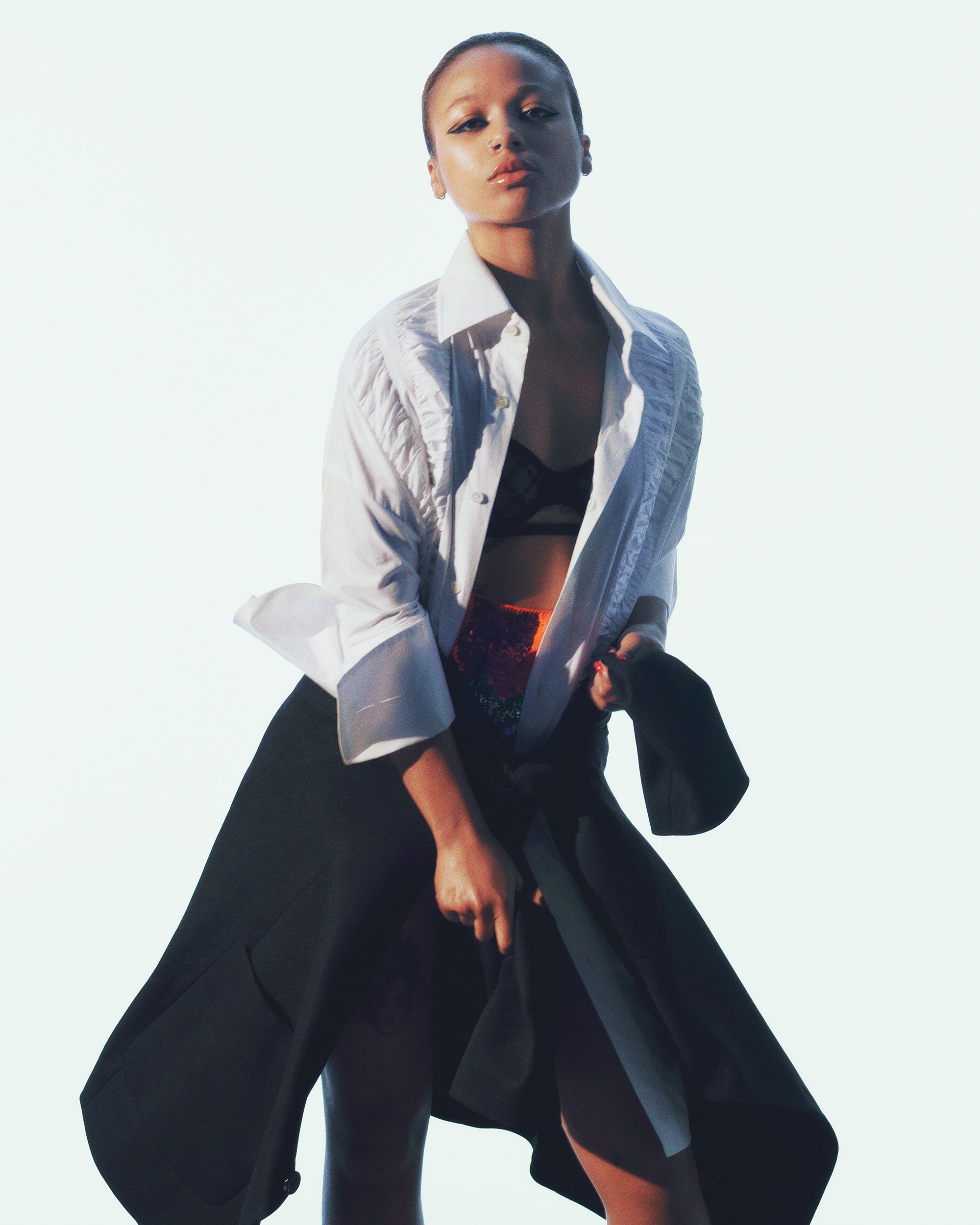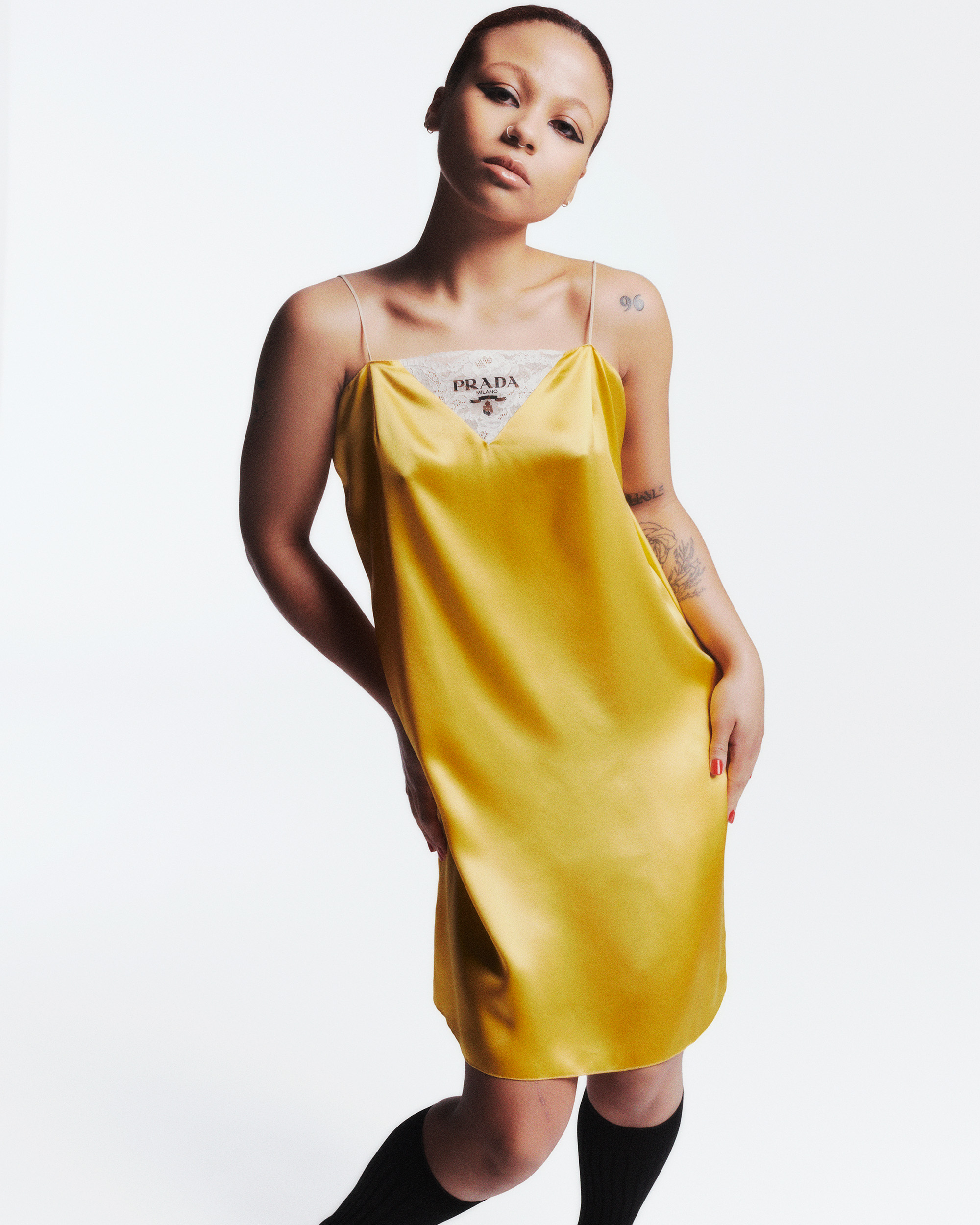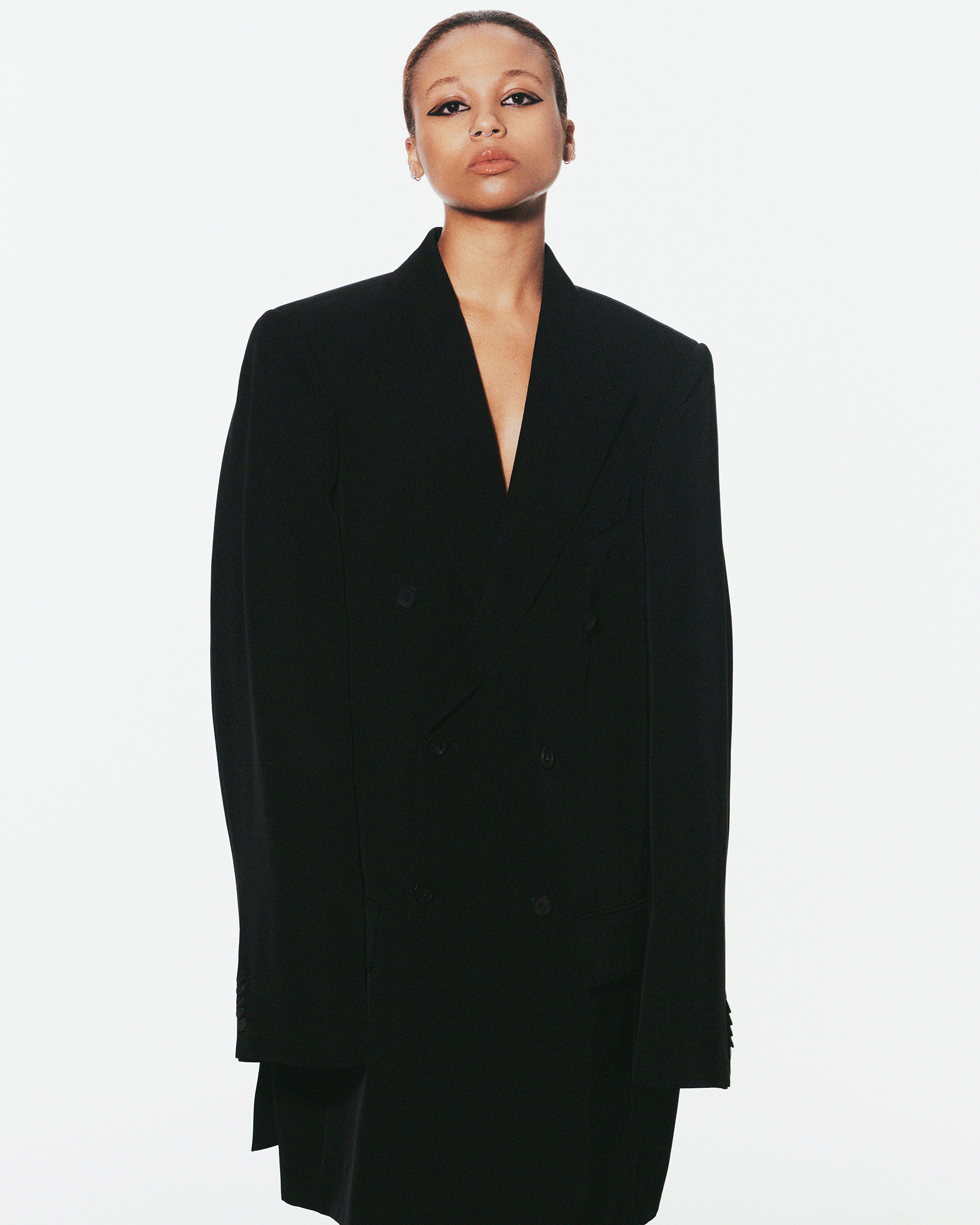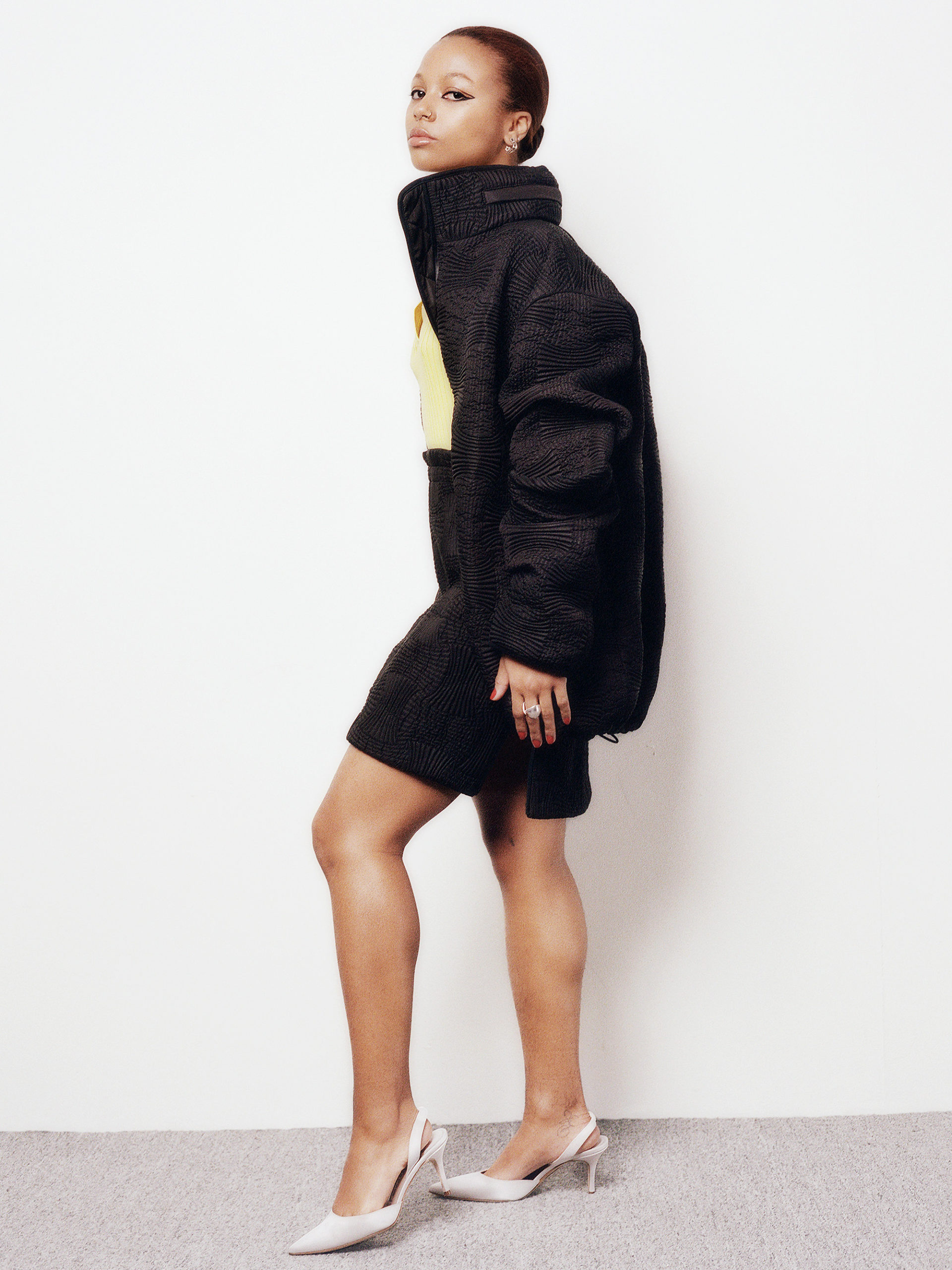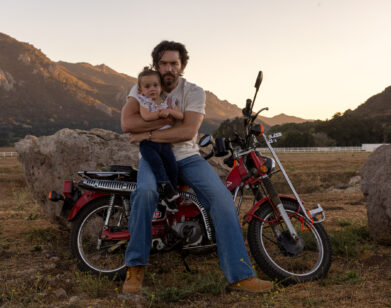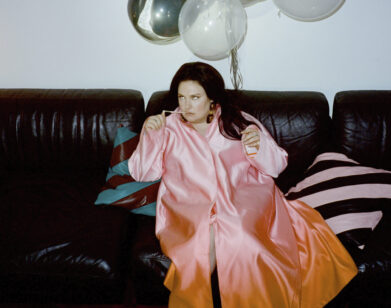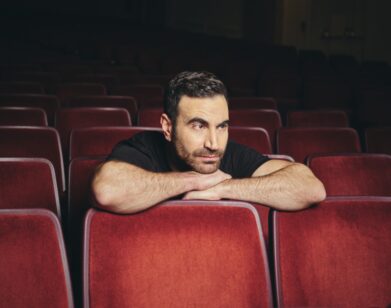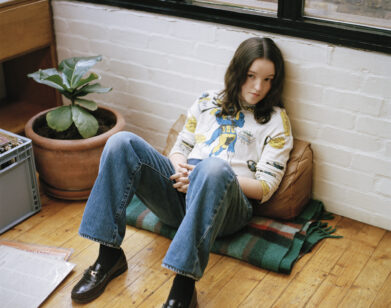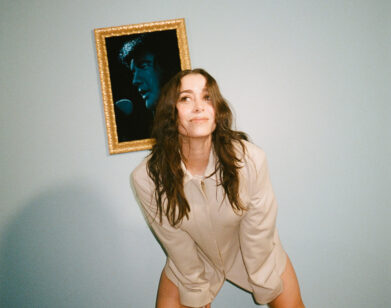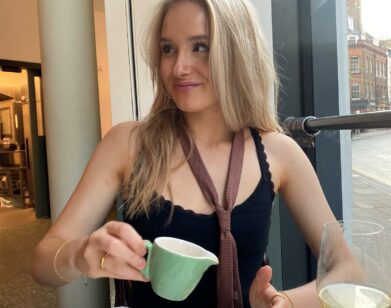Arrival
“You’re Not a Bitcoin Shorty:” Myha’la Herrold and Amandla Stenberg in Conversation
In an alternate universe, Myha’la Herrold could have been clawing her way up the corporate ladder, insecurities and white dudes the only obstacles in her way. Instead, the 26-year-old California native taps into that same energy on HBO’s sexed-up financial drama, Industry. As Harper Stern, a young woman of color vying for a position at a cutthroat London banking firm, Herrold channeled her own experiences of struggling to find her footing in the entertainment industry. But that was then and this is now. Herrold, who wrapped season two of Industry and is currently filming the family drama Leave the World Behind, will next be seen opposite a clique of young actors in Bodies Bodies Bodies, a spiky Gen Z satire masquerading as a slasher flick. One of them is Amandla Stenberg, who recently called up Herrold to talk about fan-girling to Julia Roberts on set, acting with the body, the parallels between Hollywood and Wall Street, and their recent hour-long conversation about hair. Hey everyone, Amandla is ringing her number; let’s listen in.
———
AMANDLA STENBERG: What’s up, shorty? You at home?
MYHA’LA HERROLD: Yes I am. I’m lucky that I have some days off during this project.
STENBERG: How’s it going?
HERROLD: It’s a huge learning experience. I’m on set with Julia Roberts, man.
STENBERG: Were you fan-girling?
HERROLD: I mean, I’ve known of her. Who doesn’t? But what’s really cool is watching her work. She’s super down-to-earth, really nice, very professional, and knows what the fuck she’s doing.
STENBERG: I know you love that.
HERROLD: Mahershala [Ali] is really nice as well. We have a great rapport. The whole thing’s been very, very cool.
STENBERG: Ethan Hawke is on that set too, right?
HERROLD: Yeah. He’s got jokes. He was fucking around and hurled himself into the camera and the camera started freaking out and making noises. He was like, “Oh, whatever,” about it and I was sweating. But it’s really cool. Every shot is a crane shot.
STENBERG: They have the schmoney, honey.
HERROLD: They’re like, hemorrhaging money, it’s crazy.
STENBERG: What do you feel like you’ve learned from them, collectively?
HERROLD: That’s a good question. I’m finding the balance of doing the work part of it, and pacing myself to hold onto my creative juice. Because there are huge crane shots, the setups take really long. I spend half the day in my trailer, I come back, and we work the same two pages for the whole day.
STENBERG: Wow.
HERROLD: It’s been fun to observe how the greats go through the day. Logistics stuff. Because it’s not like we come in and shoot a 13-pager, handheld the whole time for two-and-a-half-hours.
STENBERG: As we experienced. When we worked on Bodies Bodies Bodies it was like working on a play. Your background is in theater. What are some of the things that you’ve brought from that to these new environments?
HERROLD: I’m really grateful for my theater background, because it’s one of the best forms of training to prepare you for almost any medium. When you’re performing a play, you have to know the whole thing all at once. The way I approach a script is always the same: I learn the whole thing first. And I don’t necessarily mean lines, but I try to understand everything I’ve been given ahead of time to help inform the choices I make along the way.
STENBERG: Yeah.
HERROLD: With film you might shoot that shit out of order, so you have to know it even better than you might know a play. It was nice when I came to set for the first time and they were like, “What are your ideas?” I was like, “You want to know what I have to say?”
STENBERG: That’s a lot of pressure.
HERROLD: I’ve learned that you have to figure out all the possible options first—weed out the bad ones, or the irrelevant ones, and pick the strongest choices. I try to do the internal, emotional, and intellectual work before I get there, so that when I have the opportunity to explore all the options, I already know what that might look or feel like. Then I let it happen organically.
STENBERG: It’s a strange balancing act. I worked with this French director once who described her job as being a hypnotist, which stuck with me. I think what she meant was, there’s this precarious magic you’re trying to find on set. You’re coming with preconceived notions of the character or the story, but you’re also trying to allow room for spontaneity. It’s like catching lightning in a bottle.
HERROLD: Absolutely.
STENBERG: It’s our jobs to be hypnotized, both by the previous knowledge we come to set with, and by whatever we’re arriving at.
HERROLD: That’s an interesting analogy. At first I was like, “Hypnotized? I need agency.” However, if you think about it in terms of being hypnotized into a state of readiness, then you’re completely free to respond to whatever it is that’s happening around you. I like that.
STENBERG: When we were working on Bodies, I felt there was a lot of hypnosis happening. I’ve never worked in the theater, but I imagine that state of awareness and openness is something that you have to maintain 24/7 throughout the entire performance.
HERROLD: Maybe it’s because of my training, but I don’t find it to be terribly different from film. With Bodies, we had a lot of freedom—the camera followed us. But in this movie, it’s very much about, “Hit your mark, catch this light, wait until the camera moves here to say this thing.” The camera is as much our scene partner as the people on the set.
STENBERG: It was really cool having you as a scene partner. I was trying to learn from you. The way you use your body, it seems like you’re dancing. You almost have an athletic swag to you.
HERROLD: I was on the track team. Let’s go.
STENBERG: I’m sure that also comes from your experience—you’re a musician and singer.
HERROLD: I’m trained in dance and I studied musical theater. In film, you have to understand your framing. You can be doing all kinds of craziness, but if the camera doesn’t see it, it doesn’t matter. Your whole body is seen in the theater, so the whole thing has to be connected. I’m not sure that I could act from the neck up only.
STENBERG: That’s really tight. Having only had experience in film, sometimes I get very focused on my head and my face.
HERROLD: That’s the part that matters most, if that’s what they’re catching.
STENBERG: Maybe. I remember working with Russell Hornsby on The Hate U Give, and at one point, we’re working on a pretty critical scene, and he looks deeply into my eyes, and goes, “From here,” and points from his stomach. And I’m like, “Yes, yes, yes, okay.”
HERROLD: From the deepest place.
STENBERG: I also feel like your training contributes to the characters you’re drawn to, because the ones you play are very much in their bodies. They’re active and on the edge.
HERROLD: On the edge of glory? Is what you were going to say? [Laughs]
STENBERG: Your characters are very motivated, that’s for sure.
HERROLD: This character that I’m playing now, I was like, “This would be a cool, fun departure from what I’ve done before.” And then I was in it and I was like, “My hair is curled on this one, but I’m still coming for people’s necks.” Which is so funny, because I wouldn’t necessarily say all the characters are the same, but the knife point is there, and it’s ready for whatever, whenever.
STENBERG: That makes for very riveting performances. The thing about characters is, they need to be active. Otherwise, nothing is happening.
HERROLD: That’s true.
STENBERG: Are there certain characters that you identify with or feel more passionate about than others?
HERROLD: All the things I’ve been chosen for thus far have been things that speak to me. I’m always drawn to characters who have something to overcome in order to get to what they want. The way in which they try to get there is not necessarily the best way, or the easiest way. Harper desperately wants to be the best person at her job, make the most money, and prove that she belongs. And yet, she’s so riddled with insecurity and impostor syndrome, that she ends up making all these bad decisions and doing the exact things she doesn’t want to do. Somehow, she still ends up tricking the system and getting what she wants.
STENBERG: Let me just ask a couple more questions, unrelated to impostor syndrome, the getting in your own way, the striving desperately to achieve things—I can’t relate to that at all. [Laughs] What have you learned about Harper’s world, about the world of finance? I feel like that role must have required extensive research.
HERROLD: Honestly, I discovered very quickly that I was not going to learn about finance. I wasn’t going to know stocks and bonds and trades and P&Ls.
STENBERG: You’re not a Bitcoin shorty.
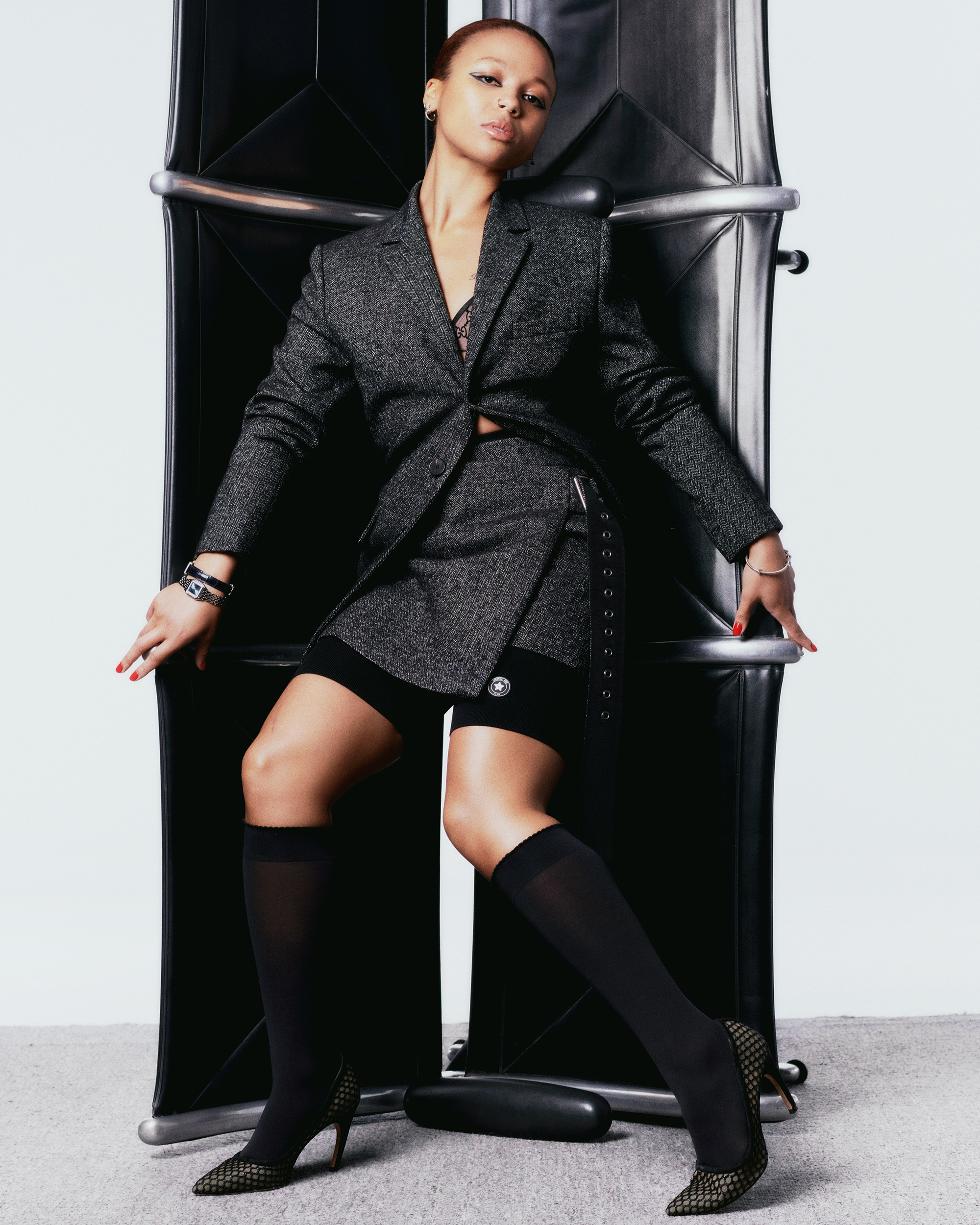
Blazer, Skort, Shorts, and Shoes by Dior. Bra by Gucci. Earrings by Cartier Juste un Clou. Watches by Cartier Tank Américaine and Panthère de Cartier. Bracelet by Écrou de Cartier. Socks by Wolford.
HERROLD: No, and it’s “Somebody better take my wallet away from me,” type shit. But what I did learn is that bankers and financiers, they’re just like us. They have the same interpersonal workplace drama that we have, it’s just linked to millions of dollars so it raises the stakes. I’m a young, Black, American woman, working in the U.K. and being asked to do something that I’m not sure I can really do, and I must be the best. The first time around, I was living the same life as Harper, except her shit was attached to bazillions of dollars, and she wasn’t telling the truth, ever.
STENBERG: You know what that feels like, to be in a multibillion dollar industry as a woman of color, as someone coming up and having to prove themselves. What have you learned from Harper in the second season? I’m curious what it’s like to live with a character for that long.
HERROLD: It’s a beautiful thing. I feel the responsibility to do her justice, because I’ve been with her for so long. In a lot of ways, I am her and she is me. Going into the second season, life was again imitating art, or the other way around. She’s more experienced, she’s more mature, and she’s a little more savvy and relaxed in her environment, which is exactly how I felt. It was about holding onto the things that made her who she was in the first season, and understanding how time and experience made her evolve. She still wants to be the most successful, she’s still going to lie and step on people’s toes, but she can do it with a lot more confidence and a lot less anxiety. The first time around she was grasping for straws and doing whatever she could. Now, she’s like, “I understand where my leverage is. I know what I can do here, and I got away with it the first time.”
STENBERG: It seems like there are a lot of beautiful parallels there. Not the scamming people’s asses part, but the gaining-confidence part.
HERROLD: Very much that.
STENBERG: You’re an insanely talented vocalist. Do you think there’s going to be an opportunity for us to hear your voice again soon?
HERROLD: I sure hope so. I really want to do a movie musical.
STENBERG: That would be so tight!
HERROLD: As much as I want to return to the stage, I don’t know when that’s going to be, and I feel like I’ve found my niche here in film and television. I want to do a live vocal like they did Les Mis. Most of the things I’ve done are modern ingenue, but I would really love to do something soft and romantic, to play someone in love who’s like, “My heart’s bursting, I’m wearing pink, and I’m singing.”
STENBERG: [Laughs] I thought it might be funny if we told the people about our recent, hour-long phone call about hair.
HERROLD: I called you because I was having a bit of a crisis. I was given the responsibility of deciding what my hair was going to look like for a project, which, some people might be like, “That’s so nice you get to decide. How fun.” However, it was suddenly my responsibility to be a designer, to coordinate with costume, to coordinate with script, to coordinate with the director.
STENBERG: And oftentimes, find a stylist.
HERROLD: Find the stylist, schedule my own damn appointment.
STENBERG: Get your hair braided.
HERROLD: I said, “Girl, I don’t know what to do.” And we had a very long, very comforting, and very validating conversation about the struggles of being a young, Black woman, dealing with folks who don’t necessarily have the perspective or the understanding of where you might be coming from. Having to make all of those decisions yourself, while dealing with the burden of, “What does it mean for the other Black women in our industry when they see this?” All of that becomes your responsibility, and you have to show up.
STENBERG: With your hair done.
HERROLD: And then somebody’s going to say something about it. They’re going to be like, “Who did that?” And you’re like, “Well, you said it was my decision.”
STENBERG: Beyond hair, we’re thinking about the implications for women of color, what impact creative decisions will have on the narrative, and the cultural significance of your character. It starts with hair, because hair is such a huge part of characterizing a Black girl. Is their hair straight? What does that mean? Did she grow up around white people? Is it pressed? What stage of her journey in love and accepting her own Blackness is she in? How does that affect how her hair looks?
HERROLD: Right. And for the both of us, as light-skin women, we then have to deal with all of that plus, “What does it mean when it’s us doing it?” All of that has to be carefully considered before any decision is made, and will continue to be considered as the process goes on. Every day, I’m like, “Damn, is this the right look? Are they going to say something on Black Twitter?”
STENBERG: Also, just wanting to honor that there is a very particular struggle that each Black woman goes through in understanding their cultural identity, and therefore their hair. But what I find exciting is, recently, it seems like there’s more room for conversation in terms of the different relationships that Black women have to their hair, or with their identity. Within film and media, there’s more knowledge of how diverse those experiences can be.
HERROLD: I agree.
STENBERG: That makes it better.
HERROLD: That does. Come on, pioneer. Doing the work.
STENBERG: Doing the work!
HERROLD: Quick story. I was walking on the street yesterday, and a young, beautiful Black woman came up to me and said, “I loved you in Industry. I felt so seen.” I’ve also had some Black women in finance message me and tell me the same thing. It was nice to be like, “You look like me, and I look like you, and you got something out of this, no matter how crazy Harper is.” That’s the thing that does it for me.
STENBERG: Also, let Black women be flawed.
HERROLD: Yes. There’s a very archetypal Black woman on screen, but there aren’t only three types of Black women. Every person’s experience is different, so that part in particular was exciting to me. She doesn’t fall into any tropes. She actually goes left every time you think she’s going to go right, and whether or not you think that’s morally correct is irrelevant, because it’s just new, and it’s honest.
STENBERG: I’m sure that having a Black girl, or woman, or nonbinary person—whoever it may be—say, “You made me feel seen,” is an experience that you’re going to continue to have, time and time again, and that’s the whole point.
HERROLD: That’s why we do it.
———
Hair: Rachel Polycarpe using Restore Perfecting Spray, Perfect Hair Day Heat Styling Spray, and Control hair Spray.
Makeup: Mical Klip
Production: Paige Viti
Photography Assistant: Nathaniel Jerome
Fashion Assistant: Blair Cannon
Production Assistant: Marina Sulmona
Manicure: Leanne Woodley at Jinsoon Nails
Tailor: Samantha McElrath
Location: Vandervoort Studio

